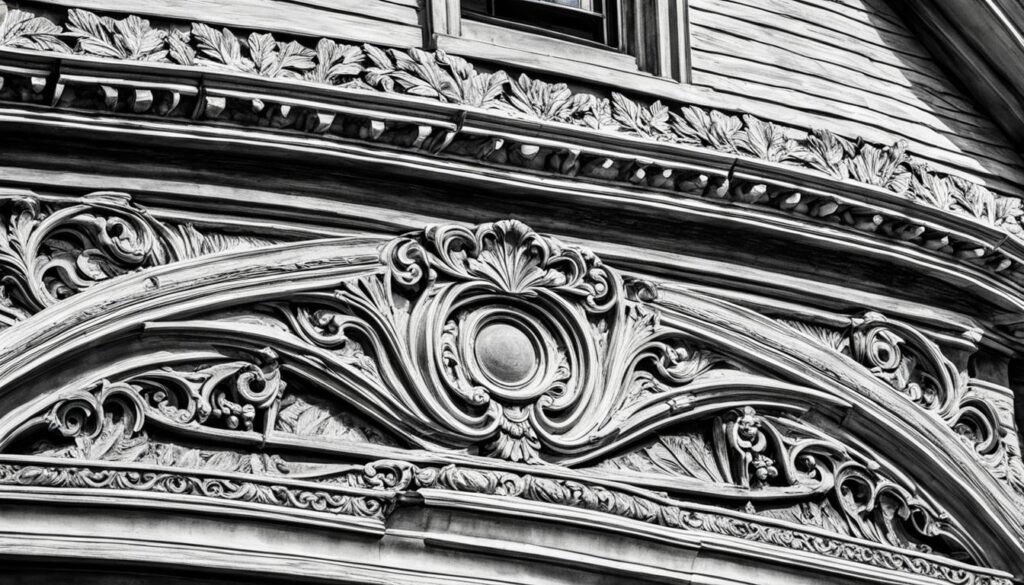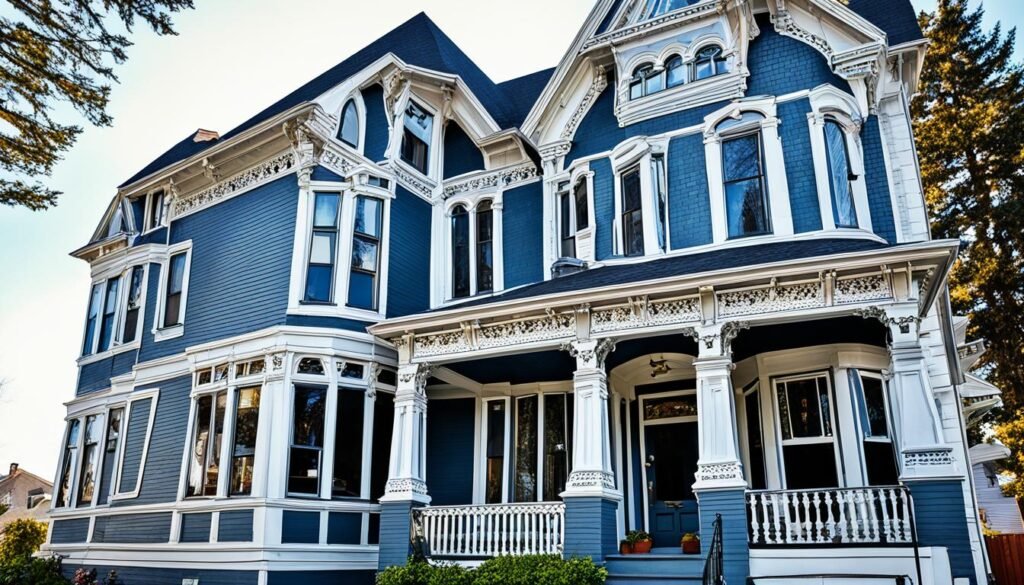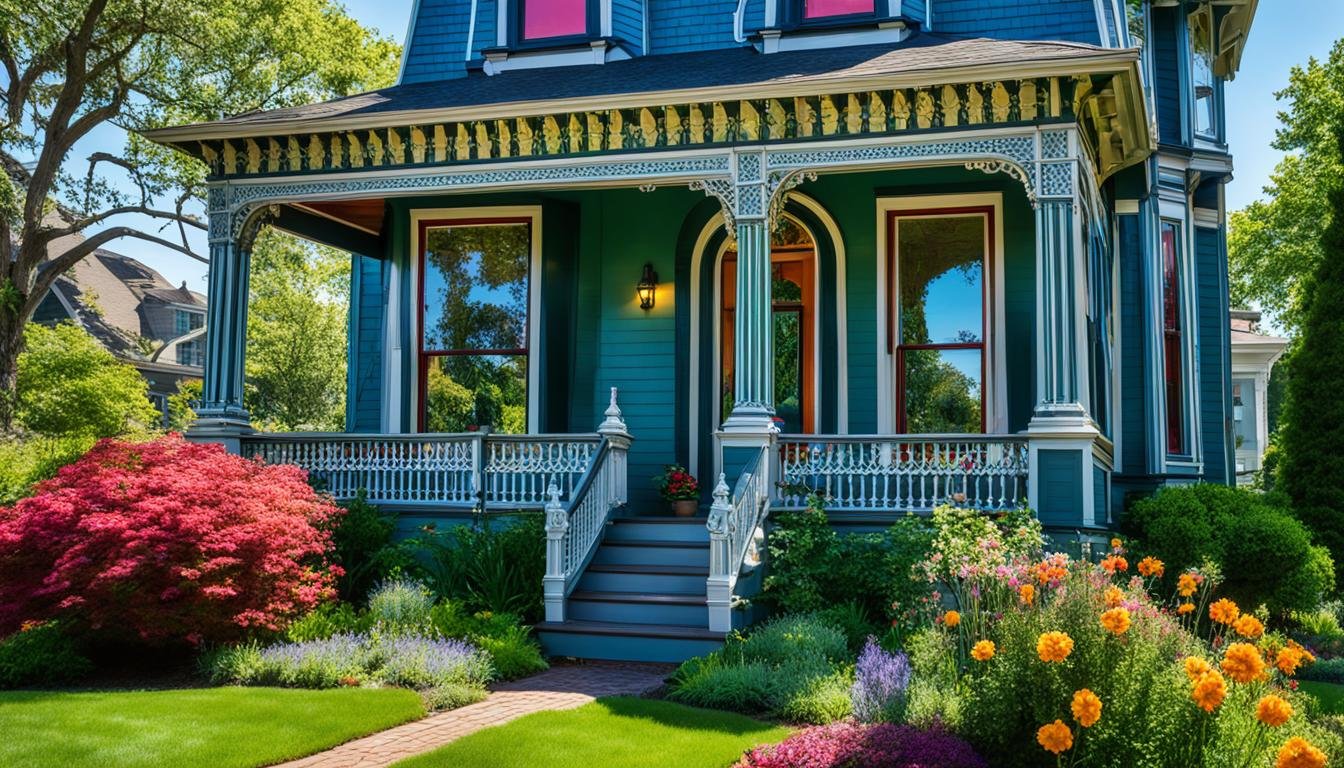Have you ever wondered how to maintain the historical integrity of older properties while still giving them a fresh and modern feel? Preserving original architectural features in older properties is not only a way to honor the past but also an opportunity to create unique and captivating spaces that stand out from the crowd. But how can you ensure that these historic homes maintain their charm and character without sacrificing functionality and style? Let’s explore the art of historic property preservation and discover the secrets to architectural conservation.
Key Takeaways
- Preserving original architectural features is essential for maintaining the historical integrity of older properties.
- Proper preservation techniques help restore design elements and increase the value of historic homes.
- Identifying and illuminating historic homes creates awareness and support for preservation efforts.
- Building relationships with homeowners and professionals is crucial for successful preservation projects.
- The economic advantages of preserving historic homes are significant and should be emphasized.
The Importance of Identifying and Illuminating Historic Homes
Preserving the historical integrity and character of older properties involves several essential steps. One of these crucial steps is identifying and illuminating the historic and architecturally significant homes within your community. By creating an inventory of these homes and raising awareness of their historical and architectural significance, you can garner support from community stakeholders and homeowners, fostering a deeper appreciation for these gems of the past.
When it comes to maintaining the historical integrity of vintage homes, knowledge is power. By conducting architectural surveys, mapping historic neighborhoods, and researching the history and design of individual homes, you can better understand and celebrate the unique elements that make these properties special. This process creates a foundation of pride and appreciation, emphasizing the social and cultural value of preserving historical architectural elements.
Identifying and illuminating historic homes is like unearthing hidden treasures, reminding us of the rich stories and intricate craftsmanship that have stood the test of time.
By shedding light on the historical significance of these homes, you encourage a sense of responsibility and promote their protection. Homeowners become more aware of the value of their properties and the positive impact of preserving historical architectural elements, whether it’s a meticulously crafted staircase, a stained glass window, or intricate crown molding.
Furthermore, identifying and illuminating historic homes serves as inspiration for both homeowners and the wider community. It sparks creativity and fosters a passion for vintage home renovation. Homeowners may feel motivated to meticulously restore and preserve original architectural features, contributing to the revitalization and charm of their neighborhoods.
The Art of Architectural Sleuthing
Identifying and illuminating historic homes requires the skills of an architectural sleuth. It involves delving into archives, poring over maps, and unearthing forgotten stories. By connecting the dots and unraveling the history of each property, you breathe life back into the past and safeguard its legacy for future generations.
Methods for Identifying and Illuminating Historic Homes
| Method | Description |
|---|---|
| Architectural Surveys | Conducting surveys to collect information about historical and architectural features of homes within a designated area. |
| Mapping Historic Neighborhoods | Creating maps that highlight the locations and historical significance of homes within a specific neighborhood or district. |
| Researching History and Design | Exploring public records, old photographs, and architectural documents to uncover the stories behind individual homes. |
Identifying and illuminating historic homes is an integral part of preserving our shared history and architectural heritage. It sets the stage for the subsequent steps in vintage home renovation, ensuring that each home’s unique story continues to inspire and captivate. Together, we can maintain the historical integrity of these magnificent properties and keep the legacy of our past alive.
Building Relationships with Homeowners and Professionals
Preserving old building character requires strong relationships with homeowners and professionals who play a crucial role in the historic building renovation process. As a preservationist or community stakeholder, you must reach out to homeowners and cultivate their interest in preserving their age-old properties when the time comes to sell. By involving architects, interior designers, contractors, inspectors, and appraisers who share a passion for architectural conservation, you can ensure that homeowners receive expert guidance on maintaining the unique character and value of their historic homes.
Collaborating with realtors and legal professionals is also essential in preserving old building character. These professionals can help establish appropriate deed restrictions and easements to safeguard the architectural integrity of these homes during future sales. With their expertise and dedication to age-old property preservation, realtors can educate potential buyers about the value of vintage homes and the benefits of maintaining historical integrity.
Building Relationships with Homeowners
When it comes to preserving old building character, establishing a rapport with homeowners is key. By engaging in open and honest conversations, you can understand their attachment to their historic properties and convey the importance of maintaining original architectural features. Encourage homeowners to share their stories and experiences living in these heritage homes, making them feel valued and invested in the preservation process. Emphasize the sense of pride and distinction that comes with owning a historic property, highlighting how their efforts contribute to the overall preservation of the community’s architectural legacy.
Collaborating with Professionals
Working closely with professionals who specialize in historic building renovation is vital for preserving the character of age-old properties. Architects skilled in architectural conservation can provide expert advice on preserving and restoring original features, ensuring that each renovation complements the building’s historical significance. Interior designers with experience in vintage home renovation can help homeowners create spaces that honor the property’s heritage while incorporating modern comforts and functionality.
Contractors and inspectors knowledgeable in historic building techniques and materials are crucial in ensuring that preservation efforts adhere to industry standards and regulations. Their expertise guarantees that any necessary repairs or modifications maintain the historical integrity of the property. Finally, involving appraisers from the start can provide homeowners with accurate assessments of their historic homes’ value, reinforcing the economic advantages of preservation. These professionals’ collective efforts will help protect the uniqueness and charm of age-old properties for future generations to enjoy.
Preservation is not a solo endeavor. By building relationships with homeowners and professionals who are passionate about preserving historic homes, you can ensure the longevity of our architectural heritage.

Benefits of Collaboration
Collaborating with homeowners and professionals in the preservation process yields numerous benefits. Homeowners gain access to a network of experts who can guide them in making informed decisions that preserve the character and value of their historic properties. Architects, interior designers, contractors, inspectors, and appraisers all contribute their knowledge and skills to ensure each renovation project is carried out with the utmost care and respect for the age-old property preservation.
Additionally, establishing relationships with realtors and legal professionals strengthens the foundation for long-term preservation efforts. Realtors who understand the significance of historic homes can effectively market these properties to potential buyers, highlighting their unique features and the sense of history that comes with owning a vintage home. Legal professionals ensure that appropriate protections are in place, safeguarding the architectural integrity of these heritage buildings for generations to come.
Roles of Professionals in Preserving Old Building Character
| Professional | Role |
|---|---|
| Architects | Provide guidance on preserving and restoring original architectural features |
| Interior Designers | Create spaces that honor the property’s heritage while incorporating modern functionality |
| Contractors | Execute renovations to adhere to industry standards and preserve historical integrity |
| Inspectors | Ensure compliance with regulations and quality of preservation efforts |
| Appraisers | Assess the value of historic properties, highlighting their economic advantages |
The Economic Advantage of Preservation
Preservationists understand the tremendous economic advantages associated with historic property preservation. By showcasing the value and marketability of these homes in Utah, they motivate homeowners, like yourself, to invest in the preservation and restoration process. Preserving historic homes not only honors the rich heritage and architectural significance but also offers tangible benefits for homeowners, the community, and future generations.
Economic Incentives
When considering the preservation of your historic property, it’s crucial to recognize the financial opportunities that arise. By providing cost estimates for renovations and determining the economic viability and value of the home once renovated, professionals, such as Sublime Home Solutions, assist you in making informed decisions.
In addition, preservation organizations and government entities often offer financial support, grants, and tax incentives for design and preservation efforts. These incentives help offset the costs of renovation and encourage homeowners to preserve their historic properties.
Inspiring Success Stories
Looking for inspiration? Consider the success stories of homeowners who have embraced historic property preservation in Utah. These homeowners have not only preserved the unique charm and character of their homes but have also witnessed the tremendous financial benefits of their investment.
One such success story is the Adams family, who restored their century-old Victorian home with the help of Sublime Home Solutions. The renovation not only increased the market value of their property but also attracted potential buyers seeking the charm and nostalgia associated with historic homes. The Adams family’s preservation journey serves as a testament to the economic advantages of historic property preservation.
A Visual Representation
To further illustrate the economic advantage of preservation, below is a visually engaging table showcasing key data from recent studies on the financial benefits of historic property preservation:
| Financial Benefits of Historic Property Preservation |
|---|
| Increased property value |
| Positive impact on local economy |
| Creation of jobs in restoration and construction industries |
| Increased tourism and revenue |
| Preservation tax credits and incentives |
As you can see, historic property preservation not only contributes to the unique character and charm of your community but also has direct economic benefits for homeowners and the surrounding area.

In the next section, we will delve into the critical role realtors play in preserving historic homes and ensuring the maintenance of their historical integrity.
The Role of Realtors in Preserving Historic Homes
When it comes to preserving historic homes, realtors play a crucial role in ensuring their architectural integrity and cultural significance are maintained. By working closely with homeowners, attorneys, and title companies, realtors can help establish deed restrictions and easements that protect these heritage buildings and their historical integrity.
But realtors aren’t just here to handle legal matters. They are also essential in educating potential buyers about the value and significance of historic properties. By highlighting the unique architectural features and the benefits of living in a vintage home, realtors can create a sense of appreciation and excitement among buyers.
“Owning a historic house is like living in a work of art. You become part of a narrative that connects the past, present, and future,” says Jane Thompson, a realtor specializing in heritage building restoration.
Realtors can play an active role in promoting the preservation of these homes by showcasing the value and beauty they possess. By partnering with preservation organizations and publishing articles and blog posts about historic homes, realtors can create awareness and generate interest among potential buyers.
Preserving Historical Integrity: The Guiding Principle
When facilitating the sale of a historic property, realtors must prioritize maintaining the home’s historical integrity. This means ensuring that any renovations or modifications align with the original design and materials used in the era the home was constructed. By preserving the unique characteristics that make vintage homes so desirable, realtors can attract buyers who appreciate the authenticity and charm of these historical properties.
Collaborating with Preservation Experts
Realtors should establish connections and collaborate with preservation experts, including architects, contractors, and home inspectors who specialize in historic building renovation. These professionals can provide invaluable guidance to both realtors and homeowners, ensuring that any renovations or modifications maintain the historical integrity of the property. By working together, realtors and preservation experts can ensure that vintage homes are preserved for future generations to enjoy.
The Economic Advantage of Vintage Home Renovation
Realtors should also highlight the economic advantages of purchasing and renovating historic homes. Vintage homes carry a unique appeal in the real estate market, often commanding higher prices compared to newer properties. By demonstrating the potential return on investment and the long-term value of owning a historic home, realtors can attract buyers who recognize the financial benefits of heritage building restoration.
“Not only do you get to own a piece of history, but you also make a smart investment. Vintage homes have proven to appreciate in value over time, making them a wise choice for buyers looking for a sound financial decision,” says Mark Johnson, a realtor specializing in maintaining historical integrity.
Preserving historic homes is a collective effort that involves homeowners, preservation organizations, and realtors. By working together, we can ensure that these architectural treasures continue to enrich our communities and preserve our cultural heritage for future generations.
| Heritage Building Restoration | Vintage Home Renovation | Maintaining Historical Integrity |
|---|---|---|
| Preserve architectural integrity | Restore unique features | Maintain historical accuracy |
| Collaborate with preservation experts | Highlight the charm of vintage homes | Educate buyers about historical value |
| Protect against inappropriate renovations | Ensure authenticity | Create awareness of heritage value |

Conclusion
Preserving the original architectural features in older properties is not just about maintaining the historical integrity and character of these homes – it’s about safeguarding a piece of our heritage. Through the five-step process of saving historic homes, communities can ensure that these architectural treasures are protected and cherished for generations to come. From identifying and illuminating historic homes to building relationships with homeowners and professionals, every step plays a crucial role in preserving the unique charm and value of these historic properties.
By actively involving preservationists, community leaders, and concerned residents, the preservation and restoration of historic homes can become a joint effort that benefits the entire community. The passion and dedication of individuals united in the mission to preserve these historical gems cannot be underestimated. Together, we can continue to honor and appreciate the invaluable contributions of past generations by preserving our architectural heritage for future ones.
So, whether it’s preserving the original trim in a Victorian home, restoring intricate stained glass windows in a Gothic Revival masterpiece, or protecting the unique craftsmanship of a Craftsman bungalow, let’s remember the importance of historic property preservation. It is through these efforts that we can ensure the stories, artistry, and ingenuity of our ancestors continue to inspire and delight us.
FAQ
Why is preserving original architectural features important in older properties?
What is the first step in preserving original architectural features in older properties?
How can building relationships with homeowners and professionals help in the preservation process?
What are the economic advantages of preserving historic homes?
What role do realtors play in preserving historic homes?
How can communities ensure the preservation of historic homes?
Source Links
- https://douglasnewby.com/2022/02/five-preservation-steps-to-saving-historic-and-architecturally-significant-homes-in-highland-park-dallas-and-cities-across-the-country/
- https://www.myoldhousefix.com/blog/historic-preservation-restoring-old-house-character
- https://www.technearchitects.com/blogs/how-to-restore-historic-and-old-heritage-buildings

Servicing various areas in Utah, Wasatch Summit and Salt Lake County, including but not limited to Eagle Mountain, Provo, Spanish Fork, Saratoga Springs, Lehi, Salem, Payson, Elk Ridge, and more, we cater to homeowners with newly built homes featuring unfinished basements. Our team of skilled professionals understands the intricacies of basement framing and uses state-of-the-art techniques and tools to exceed our clients’ expectations. (801) 687-8722


